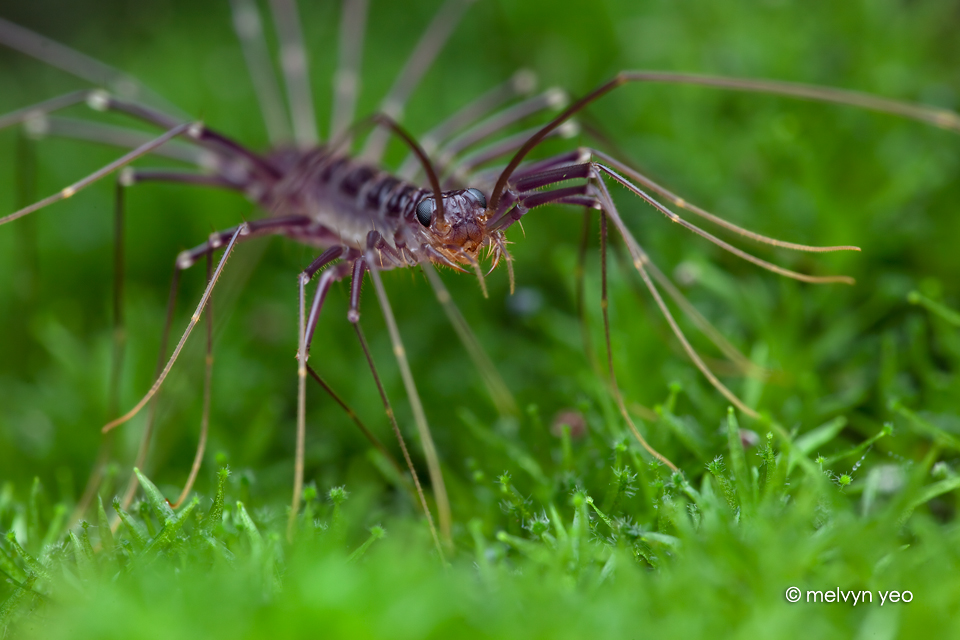ShopDreamUp AI ArtDreamUp
Deviation Actions
Description
Taken at night in Singapore forest.
Quote from en.wikipedia.org/wiki/Scutiger…
Scutigera coleoptrata – one of several species commonly known as the house centipede – is a typically yellowish-grey centipede with up to 15 pairs of legs. Originating in the Mediterranean region, the species has spread to other parts of the world, where it can live in human homes.[1] It is an insectivore; it kills and eats other arthropods, such as insects and arachnids.
The body of an adult S. coleoptrata is 25 mm (1 in) to 35 mm (1.5 in) in length.[2] Up to 15 pairs of long legs are attached to the rigid body. Together with the antennae they give the centipede an appearance of being 75 mm (3 in) to 100 mm (4 in) in length.[2] The delicate legs enable it to reach surprising speeds of up to 0.4 meters per second (1.3 ft/s)[3] running across floors, up walls and along ceilings. Its body is yellowish-grey and has three dark dorsal stripes running down its length; the legs also have dark stripes. Unlike most other centipedes, house centipedes and their close relatives have well-developed faceted eyes. S. coleoptrata has developed automimicry in that its hind legs present the appearance of antennae. When the centipede is at rest, it is not easy to tell its front from its back.
House centipedes feed on spiders, bed bugs, termites, cockroaches, silverfish, ants, and other household arthropods. They administer venom through modified legs. These are not part of their mandibles, so strictly speaking they sting rather than bite. They are mostly nocturnal hunters. Despite their developed eyes they seem to rely mostly on their antennae when hunting. Their antennae are sensitive to both smells and tactile information. They use both their mandibles and their legs for holding prey. This way they can deal with several small insects at the same time. To capture prey they either jump onto it or use their legs in a technique described as "lassoing". Using their legs to beat prey has also been described.[5] In a feeding study, S. coleoptrata showed the ability to distinguish between possible prey. They avoid dangerous insects. They also adapted their feeding pattern to the hazard the prey might pose to them. For wasps, they retreat after applying the venom to give it time to take effect.[5] When the centipede is in danger of becoming prey itself, it can detach any legs that have become trapped. House centipedes have been observed to groom their legs by curling around and grooming them with their forcipules.
Quote from en.wikipedia.org/wiki/Scutiger…
Scutigera coleoptrata – one of several species commonly known as the house centipede – is a typically yellowish-grey centipede with up to 15 pairs of legs. Originating in the Mediterranean region, the species has spread to other parts of the world, where it can live in human homes.[1] It is an insectivore; it kills and eats other arthropods, such as insects and arachnids.
The body of an adult S. coleoptrata is 25 mm (1 in) to 35 mm (1.5 in) in length.[2] Up to 15 pairs of long legs are attached to the rigid body. Together with the antennae they give the centipede an appearance of being 75 mm (3 in) to 100 mm (4 in) in length.[2] The delicate legs enable it to reach surprising speeds of up to 0.4 meters per second (1.3 ft/s)[3] running across floors, up walls and along ceilings. Its body is yellowish-grey and has three dark dorsal stripes running down its length; the legs also have dark stripes. Unlike most other centipedes, house centipedes and their close relatives have well-developed faceted eyes. S. coleoptrata has developed automimicry in that its hind legs present the appearance of antennae. When the centipede is at rest, it is not easy to tell its front from its back.
House centipedes feed on spiders, bed bugs, termites, cockroaches, silverfish, ants, and other household arthropods. They administer venom through modified legs. These are not part of their mandibles, so strictly speaking they sting rather than bite. They are mostly nocturnal hunters. Despite their developed eyes they seem to rely mostly on their antennae when hunting. Their antennae are sensitive to both smells and tactile information. They use both their mandibles and their legs for holding prey. This way they can deal with several small insects at the same time. To capture prey they either jump onto it or use their legs in a technique described as "lassoing". Using their legs to beat prey has also been described.[5] In a feeding study, S. coleoptrata showed the ability to distinguish between possible prey. They avoid dangerous insects. They also adapted their feeding pattern to the hazard the prey might pose to them. For wasps, they retreat after applying the venom to give it time to take effect.[5] When the centipede is in danger of becoming prey itself, it can detach any legs that have become trapped. House centipedes have been observed to groom their legs by curling around and grooming them with their forcipules.
Image size
960x640px 387.08 KB
Make
Canon
Model
Canon EOS 5D Mark II
Shutter Speed
1/160 second
Aperture
F/16.0
Focal Length
100 mm
ISO Speed
125
Date Taken
Nov 30, 2013, 2:07:07 AM
Sensor Size
6mm
© 2014 - 2024 melvynyeo
Comments25
Join the community to add your comment. Already a deviant? Log In
Also known as the house centipede!


































